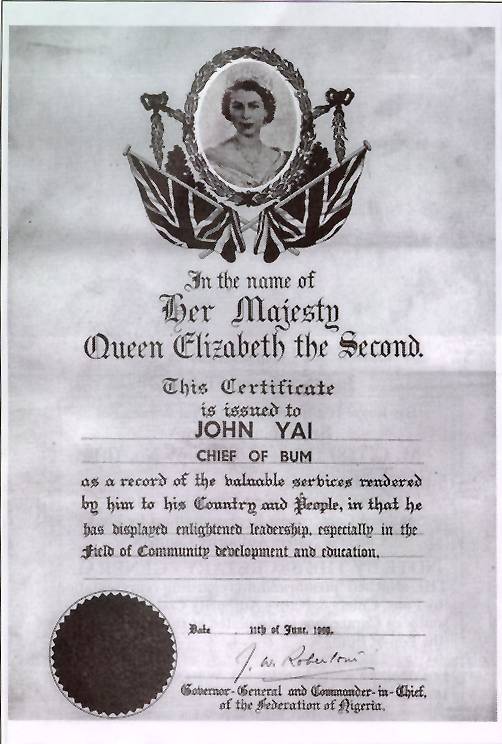CHAPTER ONE
THE POLITY OF BUM

CHAPTER ONE |
 |
LOCATION |
|---|
Bum is a polity or state system in the Boyo Division of the North-West Province of the Republic of Cameroon. They claim territorial rights over a vast region, which both Pollock (1927: 2) and Nkwi (1982: 184) described as "a high tableland with low hills interspersed with deep ravines and valleys." The people are attracted to settle in the valleys where the soil is more fertile and conducive to farming. Bum is essentially a mineral and granite region consisting of iron stone, quartz, diamond and gold. Its outstanding traditional architecture caught the attention of Lich Moseley of the Royal Niger Company, who, in about 1890, admired Bum's "large well-made houses with raised floors, inside and out" and the good furniture. (Chilver, 1993) |
PEOPLE
|
||
|---|---|---|
The Bum, who were stronger than all the other groups, established their suzerainty and promised protection for their subordinates who pay allegiance to them. Today the Bum language has been adopted by all the other peoples. The languages of Sawi and Saaff are completely dead. On the contrary, the Mbuks, Mungongs and Faats have managed to conserve their individual languages; even if these are spoken less frequently, and in limited circles. |
||
About the Tikar connection and spirit of Bum, Pollock (1927:2) says:The people of Bum share with the Bafut Peoples the distinction of being the representatives of the TIKAR races who pushed further westward than any others, they were finally prevented from advancing further afield by the WIDIKUM peoples in the South, and the MUNCHI peoples in the north and west. |
||
Various colonial accounts present Bum as well developed, strategic and strong, with a very friendly, hospitable and peaceful people who "remained quiet" at a time the surrounding areas "gave trouble" to German expansion in the region. Visitors were treated royally at the command of the Fon and given guides and the Fon's passport to continue their journey. A quality which pushed Moseley to comment:"under a simple exterior black skin, better principles and finer feelings were to be discovered than in many a European heart"; and led Fr. Johannes Emonts to write after his visit to Bum: "it was hard to believe that one was sitting among so called 'uncivilised' people." (Chilver. 1993) |
||
Relations with other fondoms were not always harmonious, especially during the years before German expansion.. The people of Bum fought with the Mbangtu and the Bikom people over smaller villages. However, they sought peace with the Bikom eventually. There were intermarriages with the Kom and those who had married in Kom acted as intermediaries in peace negotiations, until finally both peoples reached a covenant "Mukan" never to war again. With the Banso on the other hand, good relations have always existed. This dates back to the period when the people of Banso had war with Iden and one of the Nso Chindas was captured and sent to Bum to be sold as a slave. The Fon of Bum instead released him, clothed him well and sent him back to Nso. The Fon of Nso was very happy as he thought he had lost his servant, and said that Nso "would have to live cooperatively with Bum". Generally, the fondom of Bum exchange visits and visitors with other fondoms during happy and sad moments. |
This page was created by Ian Fowler